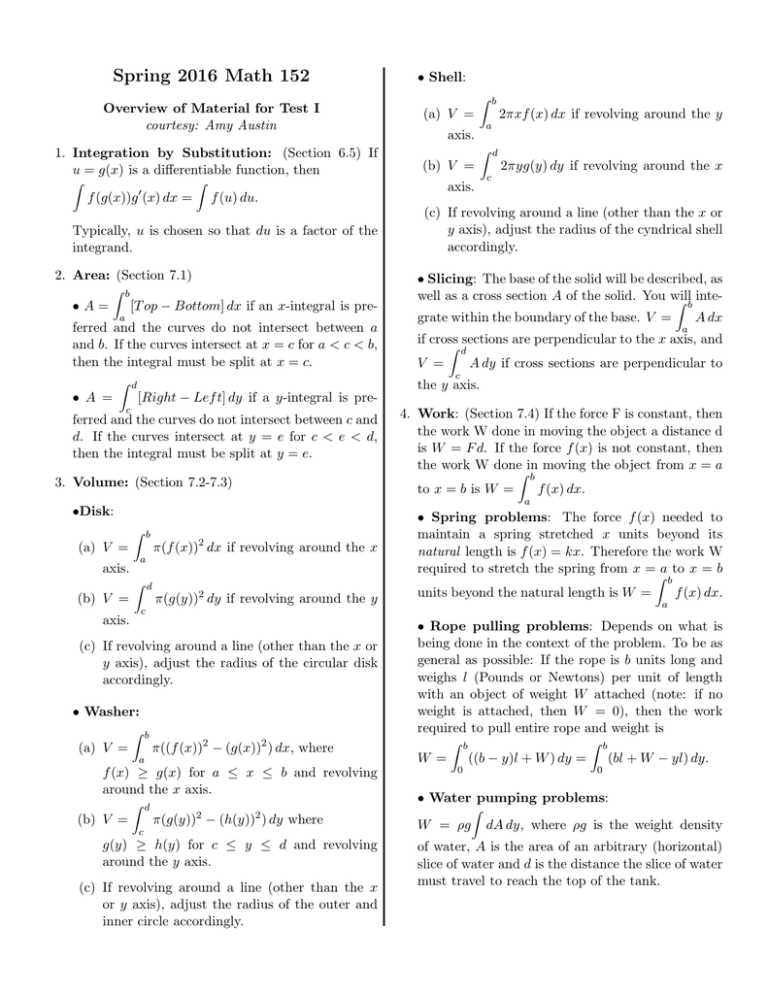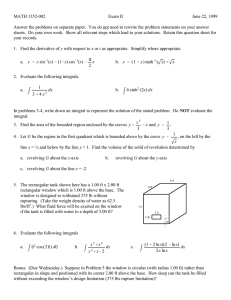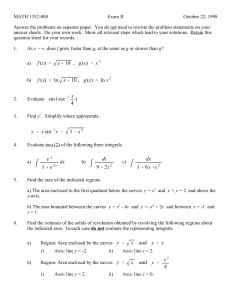Spring 2016 Math 152
advertisement

Spring 2016 Math 152 Overview of Material for Test I courtesy: Amy Austin 1. Integration by Substitution: (Section 6.5) If u = g(x) is a differentiable function, then Z f (g(x))g ′ (x) dx = Z 2. Area: (Section 7.1) •A= b [T op − Bottom] dx if an x-integral is pre- a ferred and the curves do not intersect between a and b. If the curves intersect at x = c for a < c < b, then the integral must be split at x = c. • A = Z (a) V = d [Right − Lef t] dy if a y-integral is pre- c ferred and the curves do not intersect between c and d. If the curves intersect at y = e for c < e < d, then the integral must be split at y = e. 3. Volume: (Section 7.2-7.3) Z b 2πxf (x) dx if revolving around the y a axis. (b) V = Z d 2πyg(y) dy if revolving around the x c axis. f (u) du. Typically, u is chosen so that du is a factor of the integrand. Z • Shell: (c) If revolving around a line (other than the x or y axis), adjust the radius of the cyndrical shell accordingly. • Slicing: The base of the solid will be described, as well as a cross section A of the solid. You will Z inteb grate within the boundary of the base. V = A dx a if cross sections are perpendicular to the x axis, and V = Z d A dy if cross sections are perpendicular to c the y axis. 4. Work: (Section 7.4) If the force F is constant, then the work W done in moving the object a distance d is W = F d. If the force f (x) is not constant, then the work W doneZ in moving the object from x = a b f (x) dx. to x = b is W = a •Disk: (a) V = Z b π(f (x))2 dx if revolving around the x a axis. (b) V = Z • Spring problems: The force f (x) needed to maintain a spring stretched x units beyond its natural length is f (x) = kx. Therefore the work W required to stretch the spring from x =Za to x = b b d 2 π(g(y)) dy if revolving around the y a c axis. (c) If revolving around a line (other than the x or y axis), adjust the radius of the circular disk accordingly. • Washer: (a) V = Z b π((f (x))2 − (g(x))2 ) dx, where a f (x) ≥ g(x) for a ≤ x ≤ b and revolving around the x axis. (b) V = Z d π(g(y))2 − (h(y))2 ) dy where c g(y) ≥ h(y) for c ≤ y ≤ d and revolving around the y axis. (c) If revolving around a line (other than the x or y axis), adjust the radius of the outer and inner circle accordingly. f (x) dx. units beyond the natural length is W = • Rope pulling problems: Depends on what is being done in the context of the problem. To be as general as possible: If the rope is b units long and weighs l (Pounds or Newtons) per unit of length with an object of weight W attached (note: if no weight is attached, then W = 0), then the work required to pull entire rope and weight is W = Z b ((b − y)l + W ) dy = 0 Z b (bl + W − yl) dy. 0 • Water pumping problems: W = ρg Z dA dy, where ρg is the weight density of water, A is the area of an arbitrary (horizontal) slice of water and d is the distance the slice of water must travel to reach the top of the tank. 5. Average Value: (Section 7.5) • The average value of f (x) from x = a to x = b is Z b 1 f (x) dx. fave = b−a a • The Mean Value Theorem for Integrals states that if f (x) is continuous over the interval [a, b], then there is a number c, a ≤ c ≤ b so that f (c) = fave . 6. Integration by Parts: (Section 8.1) Formula: Z u dv = uv − Z v du. You much choose 7. Trig Integrals (Section 8.2) • Integrals of the form Z sinm x cosn x dx: a.) If m is odd (and positive), factor out one sine and use sin2 x = 1 − cos2 x. Then, substitute u = cos x. b.) If n is odd (and positive), factor out one cosine and use cos2 x = 1 − sin2 x. Then, substitute u = sin x. u and dv. Helpful acronym: LIPET. In order, let u equal the word that follows. Then dv is rest of the acronym. d.) If both m and n are even, use the identities: L=logarithm I=Inverse trig function P=Polynomial • Case I: (b) (c) Z Z xn ekx dx: u = xn ; dv = ekx dx xn sin(kx) dx: u = xn ; dv = sin(kx)dx xn cos(kx) dx: u = xn ; dv = cos(kx)dx • Case II: Z xn (ln x) dx: u = ln x ; dv = xn dx • Case III: (a) (b) (c) Z Z Z arccos x dx: u = arccos x ; dv = dx arcsin x dx: u = arcsin x ; dv = dx arctan x dx: u = arctan x ; dv = dx • Case IV: The Loop! This requires two iterations of integration by parts. Z ex cos x dx or Z cos2 x = Z 1 (1 + cos 2x) 2 tanm x secn x dx: a.) If m is odd (and positive), factor out one sec x tan x and use tan2 x = sec2 x − 1. Then, substitute u = sec x. T=Trigonometric (a) 1 sin2 x = (1 − cos 2x) 2 • Integrals of the form E=Exponential (ie ex ) Z c.) If both m and n are odd, use either case above (but not both). ex sin x dx, choose u however you wish. When you integrate by parts again, choose u as you did in the first iteration of integration by parts. b.) If n is even (and positive), factor out one sec2 x and use the identity sec2 x = 1 + tan2 x. Then, substitute u = tan x. c.) If m is odd and n is even, use either case above (but not both). d.) If m is even and n is odd, try breaking up into sines and cosines.






